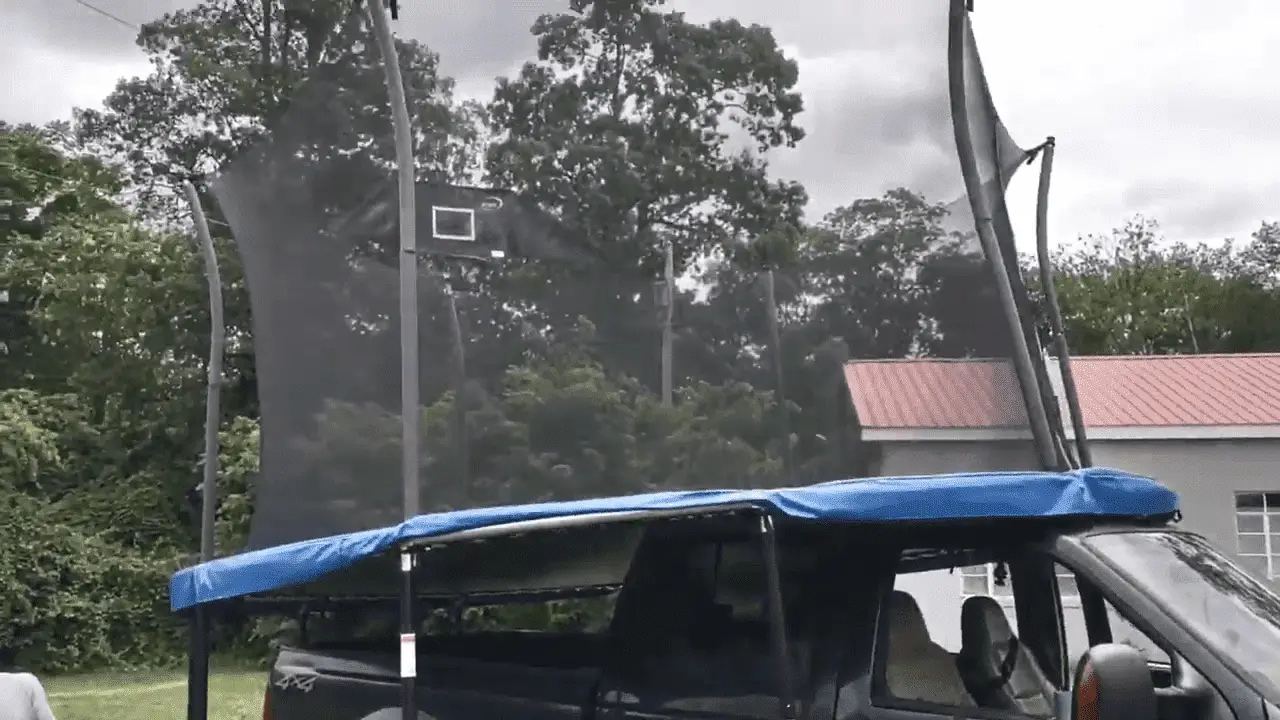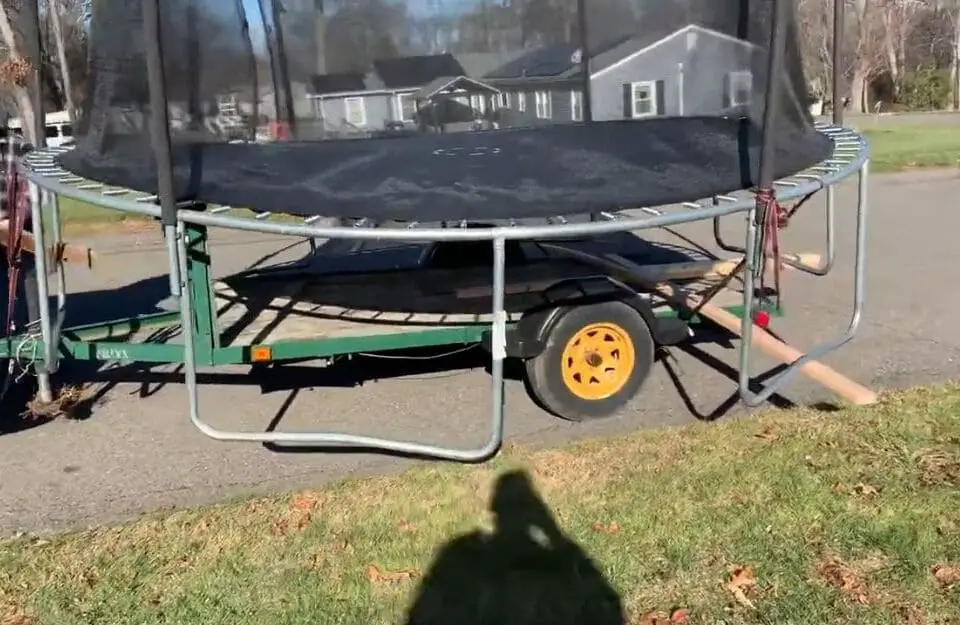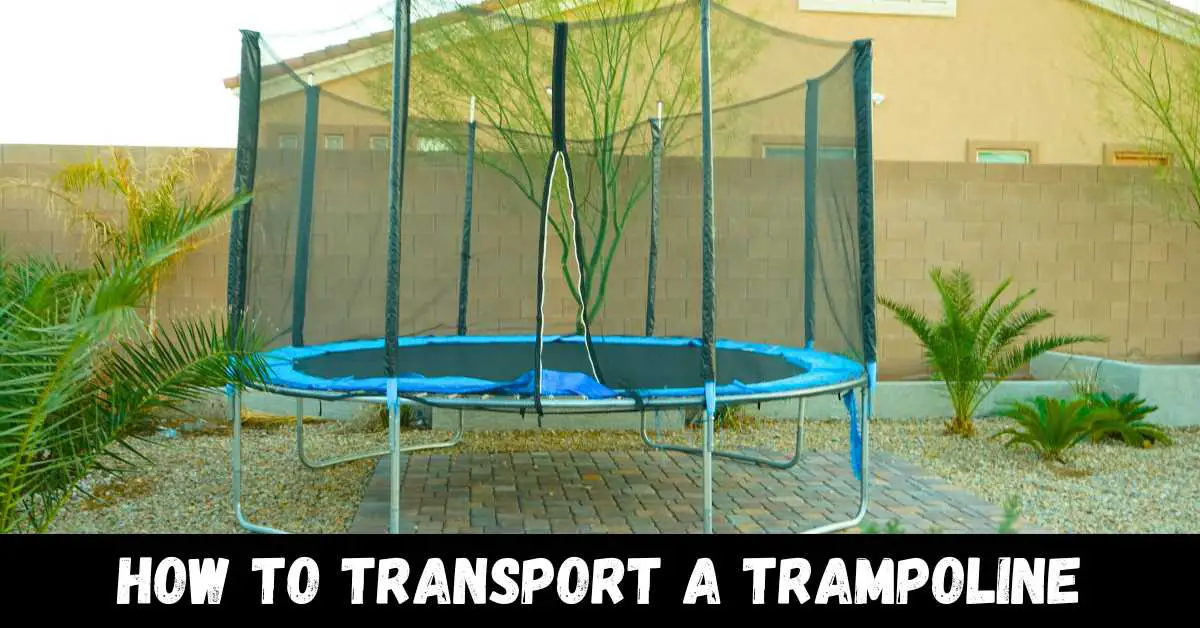How to transport a trampoline? Transporting a trampoline can seem like a daunting task, but with careful planning and proper techniques, it can be done safely and efficiently. As a trampoline owner, I have successfully moved it to a new location without dismantling it.
The key is to start with thorough preparation, including gathering the necessary equipment and supplies, assessing the new location for suitability, and ensuring safety measures are in place.
During the moving process, I securely strap and balance the trampoline on a trailer, taking extra care to prevent any damage during transportation. I also enlisted the help of a team to ensure safe lifting and carrying while following the manufacturer’s instructions and taking necessary precautions.
With patience and coordination, I successfully transported my trampoline to the new location and reassembled it using proper techniques.
It was a rewarding experience knowing that I was able to move my trampoline without any issues, and now I can enjoy it in my new backyard with peace of mind.
How to Transport a Trampoline? First, confirm the trailer width matches your trampoline. Lift and place the trampoline on the trailer. Use sturdy ratchet straps to secure it.
Preparation
Preparation is key when it comes to transporting a trampoline:
Gathering necessary equipment and supplies:
Before transporting a trampoline, it’s important to gather all the necessary equipment and supplies. This may include a trailer that matches the width of the trampoline, high-quality ratchet straps or bungee cords, padding or protective covers, and any tools needed for disassembly or reassembly.
Ensure all the equipment and supplies are in good condition and readily available before starting the transport process.
Assessing the new location for suitability:

Before moving the trampoline, assess the new location where it will be transported and set up. Ensure that it is a suitable spot that meets the safe and proper installation requirements.
Check for enough space to accommodate the trampoline, a flat and stable surface, and no potential obstacles or hazards that may hinder installation.
Ensuring safety measures are in place:
Prioritizing safety during trampoline transport is essential. Ensure the trailer is in good condition, properly hitched to the vehicle, and capable of securely holding the trampoline.
Inspect the trampoline for any loose or damaged parts, and address them before transport to prevent further damage. Use high-quality ratchet straps or bungee cords to securely fasten the trampoline to the trailer, following proper guidelines for securing the load.
Consider using padding or protective covers to prevent any potential damage to the trampoline during transport.
By carefully gathering the necessary equipment and supplies, assessing the new location for suitability, and ensuring proper safety measures are in place, you can ensure a smooth and safe trampoline transport process.
How to Transport a Trampoline: Step-by-Step Moving Process
Here is the step-by-step moving process for how to transport a trampoline:
Using a Trailer
Transporting a trampoline using a trailer can be an efficient method for moving it to a new location. To start, make sure the trailer matches the width of your trampoline. Then, lift the trampoline and place it on the trailer, ensuring it is centered and balanced.
Use high-quality ratchet straps to securely fasten the trampoline to the trailer, preventing movement during transportation. It’s crucial to ensure stability and balance throughout the moving process to avoid damage.
Upon arrival at the new location, carefully unload the trampoline from the trailer and follow the manufacturer’s instructions to reassemble it, ensuring all parts are properly aligned and securely attached.
Disassembling and Reassembling in Sections
If you prefer to disassemble the trampoline for transport, start by taking it apart in manageable sections. Label and organize the disassembled parts to make reassembly easier.
Safely transport the sections to the new location, taking care to protect them from damage. Once at the new location, follow the manufacturer’s instructions to reassemble the trampoline, using proper techniques and tools to ensure its stability and safety.
Moving with Multiple People

Moving a trampoline with multiple people can make the process easier and safer. Coordinate and communicate with your team to ensure everyone is on the same page.
Properly lift and carry the trampoline, using proper lifting techniques to avoid causing damage to the trampoline or injury to yourself. Safely transport the trampoline to the new location, using teamwork to ensure stability and balance.
Assemble the trampoline at the new location according to the manufacturer’s instructions, making sure all parts are properly attached and secure.
Note: It’s always recommended to refer to the manufacturer’s instructions for specific guidance on transporting and reassembling your trampoline, as different trampoline models may have unique requirements.
Safety should be a top priority during the moving process to prevent accidents or damage to the trampoline.
Loading the Trampoline
Here, we will talk about loading the trampoline:
Choosing an Appropriate Vehicle for Transport
- Consider the size and weight of the trampoline.
- Select a vehicle that can accommodate the trampoline and its disassembled components.
- Ensure the vehicle is in good working condition and has the necessary towing capacity, if applicable.
- Verify that your chosen vehicle complies with local regulations for oversized loads.
Ensuring the Trampoline’s Components Fit Inside the Vehicle
- Measure the trampoline components to confirm they will fit inside the vehicle.
- Consider removing seats or rearranging the interior to create more space.
- Safely load the trampoline components into the vehicle, taking care not to damage them during the process.
Securing the Trampoline on the Vehicle’s Roof or in the Bed of a Truck
- Use an appropriate roof rack or truck bed to transport the trampoline.
- Ensure the roof or truck bed is clean and free from any debris or sharp objects that could damage the trampoline.
- Place a protective layer, such as blankets or foam pads, between the trampoline and the roof or truck bed to prevent scratching.
Balancing the Weight Distribution
- Distribute the trampoline components evenly to maintain a balanced weight distribution.
- Avoid overloading one side of the vehicle, which can affect stability and handling.
- Use plywood sheets to create a flat and stable base for the trampoline components.
Strapping Down the Trampoline Securely
- Use ratchet straps or heavy-duty bungee cords to secure the trampoline components to the roof rack or within the truck bed.
- Start by attaching straps to the frame or base of the trampoline and then to the vehicle’s anchor points.
- Tighten the straps or cords securely, ensuring there is minimal movement or shifting of the trampoline during transit.
- Double-check that the trampoline is tightly fastened from multiple angles to prevent any wiggle room.
Double-Checking All Connections and Straps
- Conduct a thorough inspection of all straps, connections, and anchor points to ensure they are secure.
- Test the stability of the trampoline by gently shaking or nudging it to see if it remains in place.
- Re-tighten straps if necessary, ensuring they remain taut throughout the journey.
- Be prepared with additional straps or tie-downs in case of any unexpected loosening during transit.
Troubleshooting and Tips
Moving a trampoline can sometimes present challenges, but you can overcome them with proper planning and precautions. Here are some standard troubleshooting scenarios and tips to address them:
Addressing common challenges and providing solutions:
Some common challenges during trampoline transportation include securing the trampoline on the trailer, protecting vulnerable parts, maintaining stability during transit, and ensuring proper reassembly.
Solutions include using high-quality ratchet straps, padding, or bubble wrap for protection, double-checking stability, and following the manufacturer’s instructions for reassembly.
Tips for safely moving a trampoline without dismantling it:
If you are moving a trampoline without dismantling it, here are some tips to consider:
- Use professional-grade straps to ensure the trampoline is securely fastened to a truck or van.
- Protect vulnerable parts such as the frame and springs with padding or bubble wrap to prevent damage during transportation.
- Avoid sharp turns, sudden stops, and excessive speed during transit to prevent shifting or toppling of the trampoline.
- Check the trampoline regularly during transportation to ensure it remains stable and secure.
Precautions to take during the process:
To ensure a safe trampoline move, consider the following precautions:
- Use proper lifting techniques and avoid dragging or dropping the trampoline to prevent damage to the frame, springs, or other parts.
- Wear appropriate protective gear, such as gloves and closed-toe shoes, to prevent injuries during the moving process.
- Communicate and coordinate with your team if moving with multiple people, assigning specific roles and responsibilities to ensure a smooth and safe moving process.
- Follow the manufacturer’s instructions for disassembly, transportation, and reassembly to ensure the trampoline is properly set up at the new location.
By addressing common challenges, following tips for moving without dismantling, and taking necessary precautions, you can ensure a successful trampoline move without any unnecessary damage or injuries.
FAQs:
Q:1 Can I transport a trampoline without disassembling it?
Yes, it is possible to transport a trampoline without disassembling it, but it requires careful planning and precautions. You will need to securely fasten the trampoline to a trailer or a truck using professional-grade straps.
Protect vulnerable parts such as the frame and springs with padding or bubble wrap to prevent damage during transportation. Avoid sharp turns, sudden stops, and excessive speed during transit, and regularly check the trampoline to ensure it remains stable and secure.
Q:2 Can I transport a trampoline in my car?
Transporting a trampoline in a car may not be feasible due to its large size and weight. Trampolines are typically too big to fit inside most cars and may require disassembly or a larger vehicle, such as a truck or a trailer for transportation.
If attempting to transport a trampoline in a car, ensure it is properly secured and does not obstruct the driver’s visibility or violate local traffic laws.
Q:3 How do I disassemble a trampoline for transportation?
To disassemble a trampoline for transportation, follow the manufacturer’s instructions carefully. If applicable, remove the safety net enclosure, and then detach the springs or straps from the jumping mat.
Next, disassemble the frame, taking note of the order and location of each part. Label and organize the disassembled parts, and pack them securely for transportation.
Keep any bolts, nuts, and other small parts in a labeled bag or container. It’s crucial to follow the manufacturer’s instructions to avoid damaging the trampoline during disassembly.
Q:4 How do I reassemble a trampoline after transportation?
To reassemble a trampoline after transportation, carefully unpack the disassembled parts and follow the manufacturer’s instructions in reverse order. Start by assembling the frame, attaching the legs, and securing the bolts or nuts as instructed.
Next, attach the springs or straps to the frame, and then install the jumping mat. Finally, if applicable, reattach the safety net enclosure and ensure it is properly secured.
Double-check that all parts are properly aligned and fastened according to the manufacturer’s instructions for safe and stable reassembly.
Q:5 Do I need any special equipment for transporting a trampoline?
Yes, transporting a trampoline may require some special equipment depending on the method of transportation chosen. If using a trailer, you will need professional-grade ratchet straps or bungee cords to securely fasten the trampoline to the trailer.
Bubble wrap or padding may be needed to protect vulnerable parts during transportation. If disassembling the trampoline, you may need basic hand tools such as wrenches or screwdrivers to dismantle and reassemble the trampoline.
It’s important to have the necessary equipment and supplies on hand to ensure a safe and successful trampoline transport.
Conclusion:
In conclusion, transporting a trampoline requires careful planning, preparation, and adherence to safety measures. Whether using a trailer, disassembling and reassembling in sections, or moving with a team of people, it is essential to ensure the trampoline is properly secured, protected, and stable during transportation.
Following the manufacturer’s instructions for disassembly and reassembly is crucial to prevent damage to the trampoline and ensure its safe use at the new location.
Special equipment such as professional-grade straps, padding, and hand tools may be needed depending on the method of transportation chosen. It’s also important to avoid sharp turns, sudden stops, and excessive speed during transit to prevent accidents.
By taking the necessary steps and precautions, you can safely transport your trampoline to a new location and enjoy continued fun and enjoyment on your trampoline.
After reading this comprehensive article, we hope you will be well aware of how to transport a trampoline. If you have any questions, feel free to comment below!

